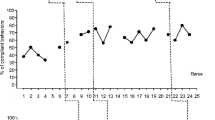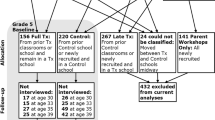Abstract
This study examined subgroup differences in the effectiveness of a universal classroom-based preventive intervention. The Good Behavior Game (GBG) was delivered in Grade 1 and 2 in a randomized controlled trial including 759 students. Changes in externalizing and internalizing problems were modeled from Kindergarten through Grade 2. Unlike previous research, a person-centered approach was employed to examine critical combinations of child, peer, family, and demographic characteristics at baseline as moderators of intervention impact. Six subgroups were identified that differed both in baseline risk profiles and intervention responsiveness. The GBG prevented the development of externalizing and internalizing behavior among low-risk children, children with emotional problems, and victimized children. No positive intervention effects were found for children from dysfunctional families and children with combinations of behavioral and social risks. The study presented a novel approach to study subgroup differences in universal preventive interventions and provides first evidence that universal school-based programs may not be effective for children with more severe risks and risks at multiple levels.

Similar content being viewed by others
References
Abidin, R. R. (1983). Parenting stress: Index manual. Charlottesville: Pediatric Psychology Press.
Achenbach, T. M. (1991). Manual for the child behavior checklist/4-18 and 1991 profile. Burlington: University of Vermont, Department of Psychiatry.
Ashford, J., Smit, F., Van Lier, P. A. C., Cuijpers, P., & Koot, H. M. (2008). Early risk indicators of internalizing problems in late childhood: A 9-year longitudinal study. Journal of Child Psychology and Psychiatry, 49, 774–780.
Barrish, H. H., Saunders, M., & Wolf, M. M. (1969). Good behavior game: Effects of individual contingencies for group consequences on disruptive behavior in a classroom. Journal of Applied Behavioral Analysis, 2, 119–124.
Beauchaine, T. P., Webster-Stratton, C., & Reid, J. (2005). Mediators, moderators, and predictors of 1-year outcomes among children treated for early-onset conduct problems: A latent growth curve analysis. Journal of Consulting and Clinical Psychology, 73, 371–388.
Bierman, K. (2002). Predictor variables associated with positive fast track outcomes at the end of third grade. Journal of Abnormal Child Psychology, 30, 37–52.
Bierman, K. L., Coie, J. D., Dodge, K. A., Greenberg, M. T., Lochman, J. E., McMahon, R. J., et al. (2010). The effects of a multiyear universal social–emotional learning program: The role of student and school characteristics. Journal of Consulting and Clinical Psychology, 78, 156–168.
Bloom, H. S., & Michalopoulos, C. (2011). When is the story in the subgroups? Strategies for interpreting and reporting intervention effects for subgroups. Prevention Science. doi:10.1007/s11121-010-0198-x.
Bronfenbrenner, U. (1977). Toward an experimental ecology of human development. American Psychologist, 32, 513–531.
Center, E. M. (2000). Problem behavior at school interview. Rotterdam: Erasmus University.
De Brock, A. J. L. L., Vermulst, A. A., Gerris, J. R. M., & Abidin, R. R. (1992). Nijmeegse Ouderlijke Stress Index (Nijmegen Parental Stress Index). Lisse: Swets & Zeitlinger.
Dodge, K. A., & Pettit, G. S. (1994). Socialization mediators of the relation between socioeconomic status and child conduct problems. Child Development, 65, 649–665.
Dolan, L. J., Jaylan, T., Werthamer, L., & Kellam, S. G. (1989). The good behavior game manual. Baltimomore, MD: The Johns Hopkins Prevention Research Center.
Eron, L., Huesmann, R., Spindler, A., Guerra, N., Henry, D., & Tolan, P. (2002). A cognitive-ecological approach to preventing aggression in urban settings: Initial outcomes for high-risk children. Journal of Consulting and Clinical Psychology, 70, 179–194.
Farrell, A. D., Henry, D. B., & Bettencourt, A. (2011a). Methodological challenges examining subgroup differences: Examples from universal school-based youth violence prevention trials. Prevention Science. doi:10.1007/s11121-011-0200-2.
Farrell, A. D., Henry, D. B., Mays, S. A., & Schoeny, M. E. (2011b). Parents as moderators of the impact of school norms and peer influences on aggression in middle school students. Child Development, 82, 146–161.
Flay, B., Biglan, A., Boruch, R., Castro, F., Gottfredson, D., Kellam, S., et al. (2005). Standards of evidence: Criteria for efficacy, effectiveness and dissemination. Prevention Science, 6, 151–175.
Ford, D. H., & Lerner, R. M. (1992). Developmental systems theory: An integrative approach. Newbury Park, CA: Sage.
Gazelle, H., & Ladd, G. W. (2003). Anxious solitude and peer exclusion: A diathesis-stress model of internalizing trajectories in childhood. Child Development, 74, 257–278.
Greca, A. M. L., Silverman, W. K., & Lochman, J. E. (2009). Moving beyond efficacy and effectiveness in child and adolescent intervention research. Journal of Consulting and Clinical Psychology, 77, 373–382.
Hawes, D. J., & Dadds, M. R. (2006). Assessing parenting practices through parent-report and direct observation during parent-training. Journal of Child and Family Studies, 15, 554–567.
Hinshaw, S. P. (2007). Moderators and mediators of treatment outcome for youth with ADHD: Understanding for whom and how interventions work. Journal of Pediatric Psychology, 32, 664–675.
Ialongo, N. S., Werthamer, L., Kellam, S. G., Brown, C. H., Wang, S., & Lin, Y. (1999). Proximal impact of two first-grade preventive interventions on the early risk behaviors for later substance abuse, depression, and antisocial behavior. American Journal of Community Psychology, 27, 599–641.
Ialongo, N., Poduska, J., Werthamer, L., & Kellam, S. (2001). The distal impact of two first-grade preventive interventions on conduct problems and disorder in early adolescence. Journal of Emotional and Behavioral Disorders, 9, 146–160.
Jung, T., & Wickrama, K. A. S. (2008). An introduction to latent class growth analysis and growth mixture modeling. Social and Personality Psychology Compass, 2/1, 302–314.
Kahn, R. S., Brandt, D., & Whitaker, R. C. (2004). Combined effect of mothers' and fathers' mental health symptoms on children's behavioral and emotional well-being. Archives of Pediatric and Adolescent Medicine, 158, 721–729.
Kellam, S. G., Rebok, G. W., Ialongo, N., & Mayer, L. S. (1994). The course and malleability of aggressive behavior from early first grade into middle school: Results of a developmental epidemiologically-based preventive trial. Journal of Child Psychology and Psychiatry, 35, 259–281.
Kellam, S. G., Brown, C. H., Poduska, J. M., Ialongo, N. S., Wang, W., Toyinbo, P., et al. (2008). Effects of a universal classroom behavior management program in first and second grades on young adult behavioral, psychiatric, and social outcomes. Drug and Alcohol Dependence, 95, 5–28.
Kessler, R. C., Andrwes, G., Colpe, L. J., Hiripi, E. M., Roczek, D. K., Normand, S.-L. T., et al. (2002). Short screening scales to monitor population prevalences and trends in non-specific psychological distress. Psychological Medicine, 32, 959–976.
Ladd, G. W. (2006). Peer rejection, aggressive or withdrawn behavior, and psychological maladjustment from ages 5 to 12: An examination of four predictive models. Child Development, 77, 822–846.
Lanza, S., & Rhoades, B. (2011). Latent class analysis: An alternative perspective on subgroup analysis in prevention and treatment. Prevention Science. doi:10.1007/s11121-011-0201-1.
Lochman, J. E. (2004). Contextual factors in the risk and prevention research. Merrill-Palmer Quarterly, 50, 311–325.
Lochman, J. E. (2006). Translation of research into interventions. International Journal of Behavioral Development, 30, 31–38.
Loeber, R., & Hay, D. (1997). Key issues in the development of aggression and violence from childhood to early adulthood. Annual Review of Psychology, 48, 371–410.
McKee, L., Forehand, R., Rakow, A., Reeslund, K., Roland, E., Hardcastle, E., et al. (2008). Parenting specificity: An examination of the relation between three parenting behaviors and child problem behaviors in the context of a history of caregiver depression. Behavior Modification, 32, 638–658.
Mrazek, P., & Haggerty, R. (1994). Reducing risks for mental disorders: Frontiers for preventive intervention. Washington, DC: National Academy Press.
Muthén, L. K., & Muthén, B. O. (1998–2007). Mplus (Vers. 5). Los Angeles: Muthén & Muthén.
Muthén, B., & Muthén, L. K. (2000). Integrating person-centered and variable-centered analyses: Growth mixture modeling with latent trajectory classes. Alcoholism, Clinical and Experimental Research, 24, 882–891.
Nylund, K. L., Asparouhov, T., & Muthen, B. O. (2007). Deciding on the number of classes in latent class analysis and growth mixture modeling: A Monte Carlo simulation study. Structural Equation Modeling, 14, 535–569.
Offord, D. R., Kraemer, H. C., Kazdin, A. E., Jensen, P. S., & Harrington, R. (1998). Lowering the burden of suffering from child psychiatric disorder: Trade-offs among clinical, targeted, and universal interventions. Journal of the American Academy of Child and Adolescent Psychiatry, 37, 686–694.
Parker, J., Rubin, K. H., Erath, S., Wojslawowicz, J. C., & Buskirk, A. A. (2006). Peer relationships and developmental psychopathology. In D. Cicchetti & D. Cohen (Eds.), Developmental psychopathology: Risk, disorder, and adaptation, vol. 2 (2nd ed., pp. 419–493). New York: Wiley.
Patterson, G. R., DeBaryshe, B. D., & Ramsey, E. (1989). A developmental perspective on antisocial behavior. American Psychologist, 44, 329–335.
Petras, H., Kellam, S. G., Brown, C. H., Muthén, B. O., Ialongo, N. S., & Poduska, J. M. (2008). Developmental epidemiological courses leading to antisocial personality disorder and violent and criminal behavior: Effects by young adulthood of a universal preventive intervention in first- and second-grade classrooms. Drug and Alcohol Dependence, 95, S45–S59.
Shaw, D. S., Bell, R. Q., & Gilliom, M. (2000). A truly early starter model of antisocial behavior revisited. Clinical Child and Family Psychology Review, 3, 155–172.
Shelton, K. K., Frick, P. J., & Wootton, J. (1996). Assessment of parenting practices in families of elementary school-age children. Journal of Clinical Child Psychology, 25, 317–329.
Stevens, G. W. J. M., & Vollebergh, W. A. M. (2008). Mental health in migrant children. Journal of Child Psychology and Psychiatry, 49, 276–294.
The Multisite Violence Prevention Project. (2008). The multisite violence prevention project: Impact of a universal school-based violence prevention program on social-cognitive outcomes. Prevention Science, 9, 231–244.
van Lier, P. A. C., Muthén, B. O., van der Sar, R. M., & Crijnen, A. (2004). Preventing disruptive behavior in elementary school children: Impact of a universal classroom-based intervention. Journal of Consulting and Clinical Psychology, 72, 467–478.
van Lier, P. A. C., Vuijk, P., & Crijnen, A. (2005). Understanding mechanisms of change in the development of antisocial behavior: The impact of a universal intervention. Journal of Abnormal Child Psychology, 33, 521–535.
Verhulst, F. C., Van der Ende, J., & Koot, H. M. (1997). Handleiding voor de teacher's report form. Rotterdam: Erasmus Universiteit Rotterdam.
Witvliet, M., van Lier, P. A. C., Cuijpers, P., & Koot, H. M. (2009). Testing links between childhood positive peer relations and externalizing outcomes through a randomized controlled intervention study. Journal of Consulting and Clinical Psychology, 77, 905–915.
Acknowledgements
The study was financially supported by ZonMW Grant 26200002 and NWO Grant 056-35-012.
Author information
Authors and Affiliations
Corresponding author
Rights and permissions
About this article
Cite this article
Spilt, J.L., Koot, J.M. & van Lier, P.A.C. For Whom Does It Work? Subgroup Differences in the Effects of a School-Based Universal Prevention Program. Prev Sci 14, 479–488 (2013). https://doi.org/10.1007/s11121-012-0329-7
Published:
Issue Date:
DOI: https://doi.org/10.1007/s11121-012-0329-7




